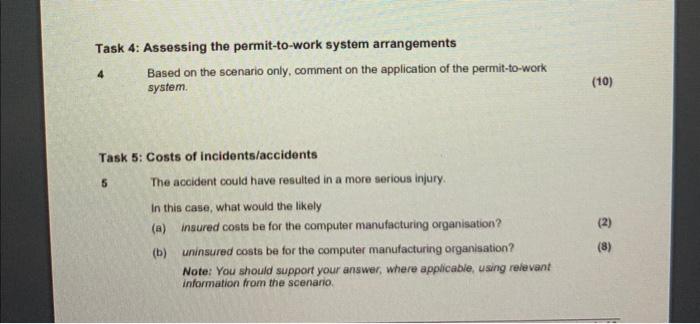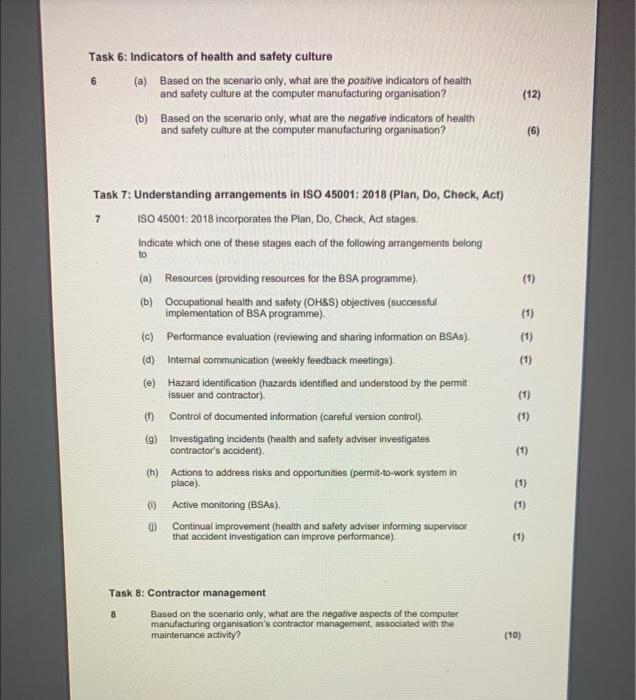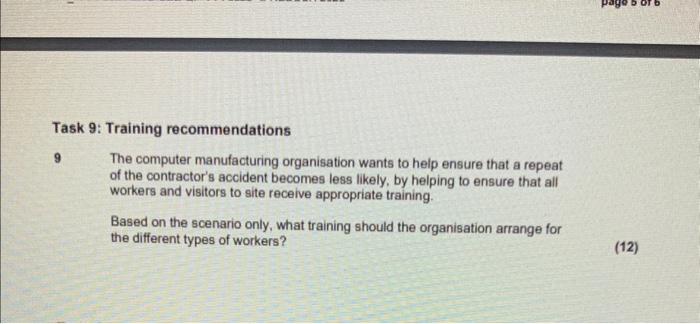write the answers quickly please??!! !!!!! must BE RELEVENT to the SCENARIO !!!!!!!
I Was posted the same quation but no one answer

SCENARIO You are a health and safety adviser for a computer manufacturing organisation that employs 150 workers and is managed by a board of six directors. Recently you have been assigned to co ordinate the project team responsible for implementing a behavioural safety audit (BSA) programme, that you are really pleased about. The directors are committed to the successful implementation of this programme as it is one of the occupational health and safety objectives for the year. The BSA programme was implemented following consultation with all workers. Each BSA involves a trained volunteer observer who watches workers, including contractors, carrying out a task in their department. The observer looks for both safe and unsafe behoviour, as well as noting the general workplace conditions at the time. There is a follow-up conversation between worker and observer, usually immediately after the observation. In this conversation, observers give praise to workers on observed safe behaviour, as well as considered verbal feedback on unsafe behaviour. You are involved in the co-ordination of ten observers' activities. The observers use a checklist of critical behaviours that were identified from studying past accidents and incidents in the organisation. The checklist is used by all departments when carrying out daily BSAs. As co-ordinator, you collect the completed checklists, collate and evaluate data, and conduct weekly feedback meetings with nominated workers in each department. All the associated forms, checklists and procedures are carefully version controlled. You report to a supervisor who is not convinced of the value of the BSA programme. This same attitude is also shared by some of the other long-serving shitt managers. You know that the introduction of the BSA programme will need careful management if it is to be accepted by your supervisor and the other managers. However, you do have the support of at least one member of the top management team, as this person has agreed to become the behavioural safety champion. They have already provided resources for you to develop behavioural safety awareness training and ensured all workers attended. Separate financial support was also provided for canying out observer training. This included special communication facilities for an observer wth hearing difficultes. A supervisor talks to you about an accident that occurred two weeks ago, where a contractor's hand was badly bruised while carrying out machinery maintenance. The contractor works for a national contracting maintenance company and was brought on site specifically to carry out the annual maintenance of one of the machines. The national contractor maintenance company has received all the necessary information on the organisation's activities that will affect the contractors coming to the site. The supervisor thinks the accident is an obvious case of 'human error' and that is not worth the time to investigate further. You disagree and argue that inveatigations can help the organisation to put things right, as human error is not the cause of all accidents. The supervisor gives you the accident report to read and suggests that any reasonable person would come to the same conclusion that they have. The supervisor says that most accidents are unavoidable; and that they think that people are always to blame. The supervisor aaks you to investgate this accident further, confident that it will prove that it was all due to human error. When the injured contractor returns to the site, you arrange a meeting with them. Although the contractor has a lot of experience, including involvement in permit-to-work systems at other organisations, this was the firat time they had worked at this manufacturing site. You ask how the injury occurred. The contractor replies that while carrying out maintenance on a piece of machinery. they dropped a screwdriver inside the machine after their sleeve snagged on a part of the machine that they had not seen. They reached into the machine which then started unexpecteoly. Fortunately, the contractor managed to retrieve the screwdriver and eacaped with just a bruised hand. The contractor decided to go to hospital following their ahift to make sure that there was not a serious injury to their hand; an x-ray confirmed that there was no fracture. You discover that the work camied out by the contractor was done under the authonty of a permil-ilowark (PTW). You decide to invesigate how the PTW system operated on that day and ask the contractor about this. They recall that they presented the job instructions to the manufacturing site's PTW issuer. The contractor is trained in the responsibilities of what accepting a permit means. The PTW issuer appeared to be extremely busy, and the contractor overheard them say that they were issuing up to 75 PTWs a day! The permit issuer, who has been doing this job for more than ten years, told the contractor about the exact nature of the job and clarifed the contractor's understanding of the hazards and risks for the proposed task. The task appeared to be low risk to the permit issuer, so they decided not to physically check the work area. However, the PTW issuer finished the conversasion by confirming that the supervisor had ensured that the machine had been isolated, included being locked out and tagged out (LOTO) (a system where padlocks are placed on a machine's start panel to stop the machine from being used while maintenance is being carried out) so that the contractor would not need to do this. You later find out that this did not actually happen. The self-duplicating PTW forms were duly completed and authorised, including relevant signatures. One copy was retained by the contractor, one copy put on display at the job location, and one kept as a record in the site office. The permit was issued to cover the period 09.0017.00 that day. The contractor also toid you that the permit issuer talked about associated control measures required for the task. The contractor telts you that the supervisor showed them to the machine that needed maintenance, and had given them a brief tour of the area. When they arrived at the machine that required maintenance, the contractor told you that they noticed that the lights above the machine were flickering. They pointed this out to the supervisor who said that they did not have anyone avalable to replace the fluorescent tube, and that the light should be sutficient for the maintenance work to be carried out. The supervisor then asked to see the contractor's risk assessment and method statement. The contractor said that they had forgotten to bring them. The supervisor was then called away by one of the workers and appeared to be stressed, lelling the contractor to do the job and that they would sort out the paperwork later. The contractor continues to say that this was the only time that they saw the supervisor on the day of the accident. They did have some questions about the machine, but the contractor was unable to find either the machine operator or the supervisor, so they carred on with the task making assumptions where necessary. The contractor finishes your conversation by telling you that it was probably their own fault that they were hurt. When you ask why, they tell you that when they were leaving the area, they picked up a sign off the floor that they had assumed had been placed on the machine as a warning. The sign read 'Dangert This machine starts when it should not. We will have to tell the maintenance person next time they are here'. Task 4: Assessing the permit-to-work system arrangements 4 Based on the scenario only, comment on the application of the permit-to-work system. (10) Task 5: Costs of incidents/accidents 5 The accident could have resulted in a more serious injury. In this case, what would the likely (a) insured costs be for the computer manufacturing organisation? (2) (b) uninsured costs be for the computer manufacturing organisation? (8) Note: You should support your answer, where applicable, using reievant information from the scenario. Task 6: Indicators of health and safety culture 6 (a) Based on the scenario only, what are the positive indicators of health and safety culture at the computer manufacturing organisation? (12) (b) Based on the scenario only, what are the negative indicators of health and safety culture at the computer manufacturing organisation? (6) Task 7: Understanding arrangements in ISO 45001:2018 (Plan, Do, Check, Act) 7 ISO 45001:2018 incorporates the Plan, Do, Check, Act stages. Indicate which one of these stages each of the following arrangements beiong to (a) Resources (providing resources for the BSA programme). (1) (b) Occupational health and safety (OH8S) objectives (successful implementation of BSA programme). (1) (c) Performance evaluation (reviewing and sharing information on BSAs). (1) (d) Internal communication (weekly feedback meetings). (1) (e) Hazard identification (hazards identified and understood by the permit issuer and contractor). (1) (f) Control of documented information (careful version control). (1) (g) Investigating incidents (health and safety adviser investigates contractor's accident). (1) (h) Actions to address risks and opportunities (permit-to-work system in place). (1) (i) Active monitoring (BSAs). (1) (3) Continual improvement (health and safety adviser informing supervisor that accident investigation can improve performance). (1) Task 8: Contractor management 8. Based on the scenario only, what are the negative aspects of the computer manufacturing organisation's contractor management, associated with the maintenance activity? (10) Task 9: Training recommendations The computer manufacturing organisation wants to help ensure that a repeat of the contractor's accident becomes less likely, by helping to ensure that all workers and visitors to site receive appropriate training. Based on the scenario only, what training should the organisation arrange for the different types of workers












